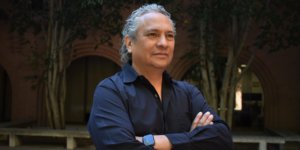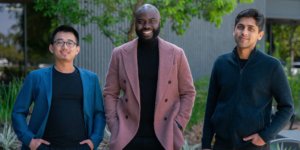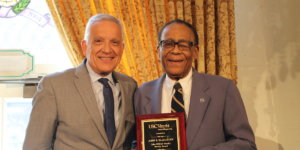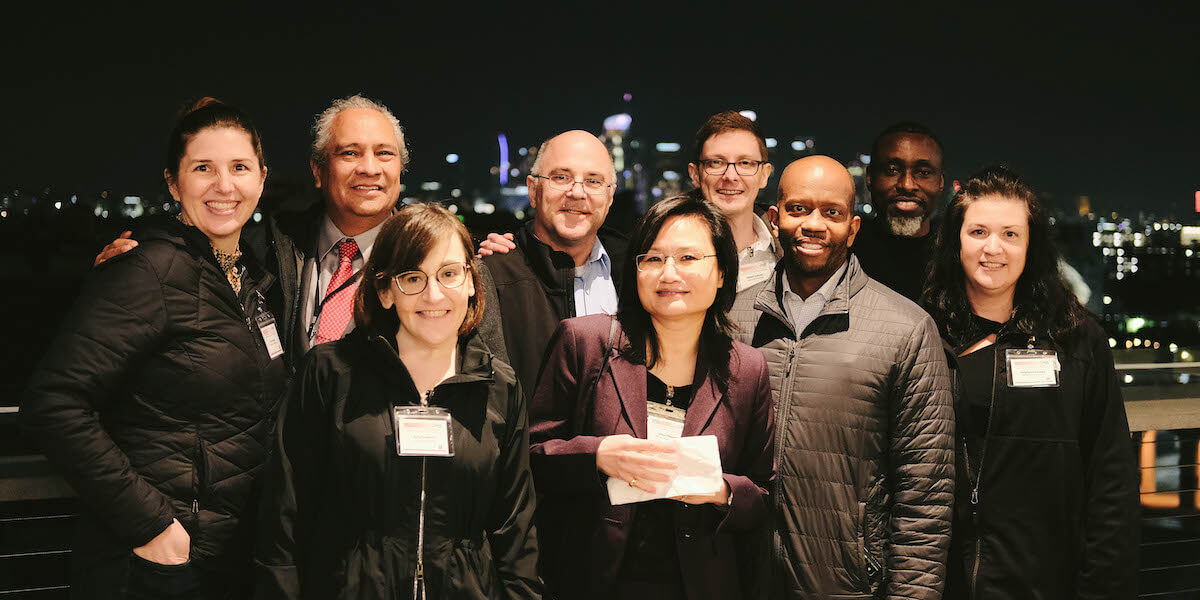
Attendees at the NSF Dare Conference enjoyed a reception at the 1923 Club at the top of the Los Angeles Memorial Coliseum. Image/Keith Wang
Imagine a future where powerful advances in artificial intelligence could help pinpoint medical issues based on real-world data from patients and help predict optimal treatment plans. In the case of stroke and other neurological conditions, these advances could be game-changing for recovery — helping clinicians and rehabilitation specialists create truly tailored treatments.
More than 140 of the nation’s leading minds in neurorehabilitation converged at the University of Southern California on March 3 – 4 to plot out a future where computation and AI can drive research and innovation and revolutionize patient outcomes.
USC’s Ronald Tutor Campus Center played host to the NSF’s Disability and Rehabilitation Engineering (DARE) Conference, which examined the theme “Transformative Opportunities for Modeling in Neurorehabilitation.” The conference organizing committee was led by Professors of Biomedical Engineering and Biokinesiology and Physical Therapy Francisco Valero-Cuevas and James Finley, along with Professors Kat Steele and Amy Orsborn from the University of Washington
The gathering aimed to identify prime opportunities for AI and computational modeling to improve the quality of life for patients managing neurological conditions like stroke, Parkinson’s disease and cerebral palsy.
The conference focused on improving the science, treatment, personalization, and daily lives of clients and caregivers, and testing hypotheses and generating predictions about the mechanisms that support and enhance development, function, recovery, and adaptation.
There were keynote talks covering emerging areas including neuroimaging for stroke rehabilitation, personalized data, assistive devices, wearable sensors and rehabilitation technology, and bringing rehabilitation to the home and work environments. The conference also featured poster sessions, podium presentations, and a memorable rooftop banquet dinner at the Los Angeles Memorial Coliseum.
Shooting for the moon in rehabilitation technology
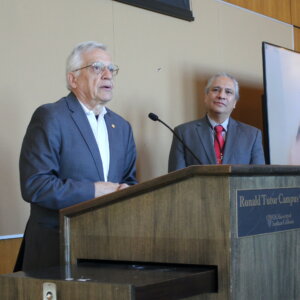
USC Viterbi Dean Yannis C. Yortsos and Professor of Biomedical Engineering and Biokinesiology and Physical Therapy Francisco Valero-Cuevas launching the NSF DARE Conference. Image/Donny Assefa.
Dean of the USC Viterbi School of Engineering Yannis C. Yortsos said the DARE conference aligned perfectly alongside two of USC’s upcoming “Moonshot” initiatives that will see significantly increased investments in both computing and health sciences at the university in coming years.
“At USC, we call ourselves a school of schools – there are 22 schools here, which makes it a very powerful place for collaboration,” Yortsos said. “I’m very happy to see a conference of this type happening right here, because it’s certainly one in which collaboration will be very important.”
Yortsos said USC Viterbi has a long-held strength in neurorehabilitation, with Valero-Cuevas a prime example of that research capacity.
“We all know the power of AI and machine learning. Digital advancements cover all aspects of our lives,” Yortsos said. “I am personally convinced that the advancements in technology will be so rapid into the next decade that we’re going to be able to solve problems that we never thought possible before.”
Valero-Cuevas said the event was an ideal and rare opportunity for established leaders in neurorehabilitation to meet with and create collaborations with rising stars and students. He said the event aimed to address one of the most pressing problems faced within the field: how the power of computational modeling can be harnessed to deliver innovation for patients and caregivers.
“Right now, we have more computational power in our phones than many of us had for our Ph.D. work,” Valero-Cuevas said. “But the challenge remains: How can we best bring computational engineering, computational mathematics and fundamentals of physiology to bear on the real-world challenges of our clients — people with disabilities, their caregivers and those in need of neurorehabilitation?”
Finley said that although the conference had a single, unifying theme, the organizers purposefully invited leading scholars whose work spanned all domains of computational neurorehabilitation.
“This created a unique setting where everyone learned about cutting-edge research outside their area of expertise,” Finley said. “Our hope is that the attendees’ experiences will ignite new collaborations and result in more innovative and effective treatments for people with neurological conditions.”
NSF Directorate for Engineering Assistant Director Susan Margulies said that the emergence of new technologies and large data sets was on track to enable personalized, predictive, dynamic rehabilitation.
“Imagine a future where rehabilitation is guided by an individual’s digital twin, for unprecedented monitoring, treatment management and predictive capability,” Marguiles said. “Advancing rehabilitation research to improve the health and lives of people across a wide range of ability levels and age is a national priority. Advancing the nation’s health is an important part of the NSF’s mission.”
Speaking to attendees, Theresa Cruz, Director of the National Institutes of Health’s National Center for Medical Rehabilitation Research, said delegates were gathered at the conference first and foremost to consider the patient’s wants and needs, and how they could best deliver to them.
“Today, I want to challenge you to imagine if you could really build the world you’re going to talk about and envision over the next couple of days. What if we could really make that happen?” Cruz said.
Alongside the NSF’s event sponsorship, the 2023 NSF DARE Conference was supported by The USC Viterbi School of Engineering, the Alfred E. Mann Department of Biomedical Engineering, the USC Division of Biokinesiology and Physical Therapy, and the National Institutes of Health.
Find more photos from the NSF DARE Conference here.
Published on March 20th, 2023
Last updated on April 12th, 2023




